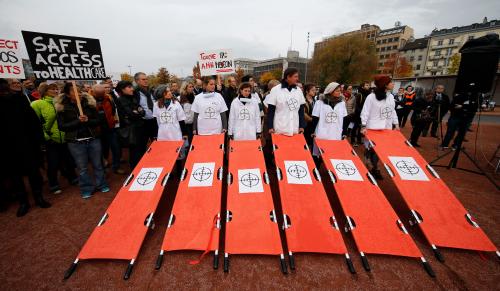Comparing the recent outbreak of swine flu to the influenza epidemic of 1918-19 may seem premature. A century ago, 50 million died — a mortality rate far, far higher than this current strain has seen so far. Yet while today’s modern world is much better prepared to deal with a public health emergency, in one respect, it is in fact more vulnerable to contagion. The integrated nature of the global economy means that international finance offers little resistance to the economic shocks that accompany pandemics.
Even with a relatively small number of cases and deaths, the global cost of a modern epidemic is large and not limited to the countries directly affected. Outbreaks inspire massive drops in the consumption of various goods and services (think tourism and group recreation); they increase businesses’ operating costs, and they speed the flight of foreign capital. The SARS epidemic in 2003 offers a telling example. As flights were cancelled, schools shut down, and panic gripped Asian markets, the relatively short-lived outbreak cost the world $40 billion.
In 2006, we estimated the likely global economic consequences of an influenza pandemic using several epidemic scenarios. The study began with a multi-country, multi-sector, dynamic model capable of describing the trade and financial linkages between and within economies. We then fed the model with a series of shocks meant to simulate the effect of pandemic: a decreased labor force, increased business costs, a shift in consumer preferences due to social distancing, and changes to risk premiums. We took into account the geography of each region and the strength of its health system. Labor supply shocks varied depending on the infection rate and mortality in a given country.
Even a mild pandemic, we discovered, would likely make a noticeable dent in global economic output. The mild scenario, estimated to cost the world 1.4 million lives, reduces total output by nearly 1 percent or approximately $330 billion (in constant 2006 prices) during the first year. In our model, as the scale of the pandemic increases, so do the economic costs. A massive global economic slowdown occurs in the next-worst scenario, with more than 142 million people killed and some output in economies in the developing world shrinking by half. The loss in output in this scenario could reach $4.4 trillion, 12.6 percent of global GDP in the first year. Of course, the composition of the slowdown would differ sharply across countries, with a major shift of global capital from the affected economies to the less-affected safe havens of North America and Europe.
In the most severe scenario, cost shocks play a much larger role in the GDP losses. Markets close down entirely. Wealth and income effects are larger in developing countries, and the contraction of demand is therefore much larger than in Europe and North America (Japan is caught in the middle). The destructive cycle feeds itself; Worse epidemiological outcomes in poorer countries perversely send much-needed capital flowing out and into industrialized economies. This exacerbates the current-account positions of the receiving countries and puts downward pressure on developing-country exchange rates. In essence, entire developing markets could become junk assets. World trade would likely contract significantly.
So far, our real-world swine flu pandemic appears to be less severe than the dire scenarios used in our modeling. But even now, the global economy is seeing some troubling signs of capital retreat. The Mexican peso, for example, has taken a hit. And just five days after news of the outbreak, it looked likely that Mexico’s government would have to tap its $47 billion credit line with the International Monetary Fund.
Although stocking Tamiflu and developing vaccines might be the most pressing priorities of the day, it will take a much longer, sustained effort to prevent a future financial catastrophe. Investing in poverty reduction and healthcare in developing countries are the keys to managing pandemics in the long term. For now, we will have to live with a world where a relatively minor flu outbreak in Mexico City can send markets reeling in Tokyo.



Commentary
Op-edWhat a Flu Pandemic Could Cost the World
April 28, 2009